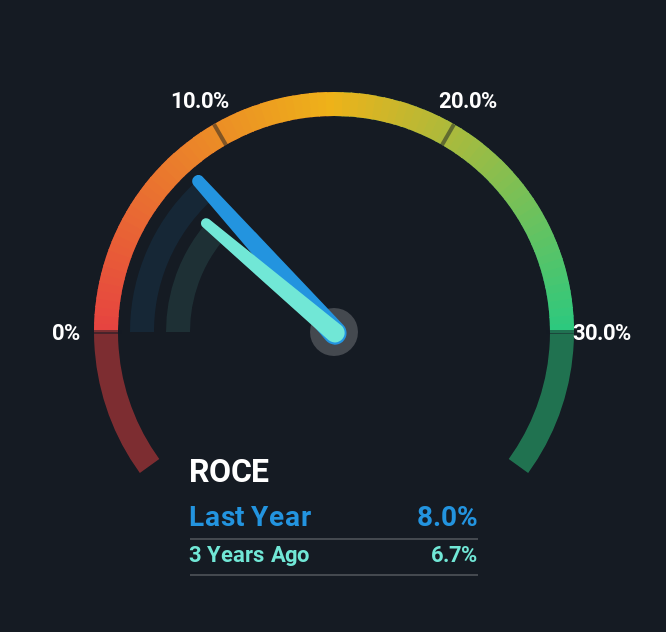Returns On Capital At UniFirst (NYSE:UNF) Have Hit The Brakes
If you're looking for a multi-bagger, there's a few things to keep an eye out for. Firstly, we'd want to identify a growing return on capital employed (ROCE) and then alongside that, an ever-increasing base of capital employed. Put simply, these types of businesses are compounding machines, meaning they are continually reinvesting their earnings at ever-higher rates of return. In light of that, when we looked at UniFirst (NYSE:UNF) and its ROCE trend, we weren't exactly thrilled.
Understanding Return On Capital Employed (ROCE)
For those who don't know, ROCE is a measure of a company's yearly pre-tax profit (its return), relative to the capital employed in the business. Analysts use this formula to calculate it for UniFirst:
Return on Capital Employed = Earnings Before Interest and Tax (EBIT) ÷ (Total Assets - Current Liabilities)
0.08 = US$200m ÷ (US$2.8b - US$267m) (Based on the trailing twelve months to May 2025).
So, UniFirst has an ROCE of 8.0%. Ultimately, that's a low return and it under-performs the Commercial Services industry average of 11%.
Check out our latest analysis for UniFirst

Above you can see how the current ROCE for UniFirst compares to its prior returns on capital, but there's only so much you can tell from the past. If you'd like, you can check out the forecasts from the analysts covering UniFirst for free.
What Does the ROCE Trend For UniFirst Tell Us?
The returns on capital haven't changed much for UniFirst in recent years. The company has consistently earned 8.0% for the last five years, and the capital employed within the business has risen 27% in that time. Given the company has increased the amount of capital employed, it appears the investments that have been made simply don't provide a high return on capital.
Our Take On UniFirst's ROCE
In summary, UniFirst has simply been reinvesting capital and generating the same low rate of return as before. Unsurprisingly then, the total return to shareholders over the last five years has been flat. Therefore based on the analysis done in this article, we don't think UniFirst has the makings of a multi-bagger.
UniFirst could be trading at an attractive price in other respects, so you might find our free intrinsic value estimation for UNF on our platform quite valuable.
While UniFirst isn't earning the highest return, check out this free list of companies that are earning high returns on equity with solid balance sheets.
Have feedback on this article? Concerned about the content? Get in touch with us directly. Alternatively, email editorial-team (at) simplywallst.com.
This article by Simply Wall St is general in nature. We provide commentary based on historical data and analyst forecasts only using an unbiased methodology and our articles are not intended to be financial advice. It does not constitute a recommendation to buy or sell any stock, and does not take account of your objectives, or your financial situation. We aim to bring you long-term focused analysis driven by fundamental data. Note that our analysis may not factor in the latest price-sensitive company announcements or qualitative material. Simply Wall St has no position in any stocks mentioned.
 Wall Street Journal
Wall Street Journal